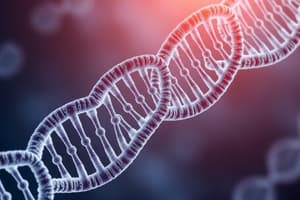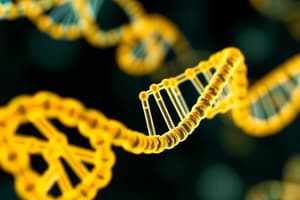Podcast
Questions and Answers
What must genetic material be able to do?
What must genetic material be able to do?
Contain information to construct an entire organism, pass from parent to offspring, be accurately copied, and account for variation.
What was the conclusion of the Griffith transformation experiment?
What was the conclusion of the Griffith transformation experiment?
- The S strain was non-virulent.
- Living S strain were not recovered.
- The R strain was transformed by the S strain. (correct)
- The experiment demonstrated that proteins were the genetic material.
Match the following components of DNA and RNA:
Match the following components of DNA and RNA:
DNA = Deoxyribose RNA = Ribose Nitrogenous base = Adenine Phosphate group = Common to both
DNA is single-stranded.
DNA is single-stranded.
The ______ bonds stabilize the structure of DNA.
The ______ bonds stabilize the structure of DNA.
What is the role of nucleotides in DNA?
What is the role of nucleotides in DNA?
Which of the following is a purine base in DNA?
Which of the following is a purine base in DNA?
How do the strands of DNA run in relation to each other?
How do the strands of DNA run in relation to each other?
The AT/GC rule states that A pairs with ______ and G pairs with ______.
The AT/GC rule states that A pairs with ______ and G pairs with ______.
What is the origin of replication?
What is the origin of replication?
Flashcards
Genetic Material
Genetic Material
The material that carries the instructions for building and maintaining an organism, passed down through generations.
Griffith Experiment
Griffith Experiment
A pivotal experiment that demonstrated that genetic material could be transferred between bacteria.
DNA vs. Protein (genetic material)
DNA vs. Protein (genetic material)
Scientists initially debated whether DNA or protein was the molecule carrying genetic information.
Nucleotide
Nucleotide
Signup and view all the flashcards
Double Helix
Double Helix
Signup and view all the flashcards
Phosphodiester Bond
Phosphodiester Bond
Signup and view all the flashcards
Base Pairing (Chargaff's Rule)
Base Pairing (Chargaff's Rule)
Signup and view all the flashcards
DNA Replication
DNA Replication
Signup and view all the flashcards
Origin of Replication
Origin of Replication
Signup and view all the flashcards
Semiconservative Replication
Semiconservative Replication
Signup and view all the flashcards
Study Notes
Chapter 11: Nucleic Acid Structure and DNA Replication
- Genetic Material Requirements:
- This implies that the genetic material must encode all the necessary information required for the development, growth, and functioning of an organism, encompassing various genes and regulatory elements.
- Must be passed between parent and offspring/cells during division.
- Must be accurately copied.
- Must account for variations within & between species.
- Early Beliefs:
- Late 1800s scientists proposed a biochemical basis for genetics.
- Researchers became convinced chromosomes held genetic information.
- 1920s-1940s, the protein portion of chromosomes was believed to be the genetic material.
- Griffith's Experiment:
- Experiment 1: Injected smooth (S) and rough (R) strains of Streptococcus pneumoniae into mice.
- S strain (encapsulated) caused death.
- R strain (non-encapsulated) did not cause death.
- Experiment 2: Injected heat-killed S strain with live R strain into mice.
- Mice died.
- Live S strain bacteria were recovered from the body of the dead mice.
- This demonstrated transformation (genetic material passed from dead S strain to live R strain bacteria).
- Experiment 1: Injected smooth (S) and rough (R) strains of Streptococcus pneumoniae into mice.
- Conclusion of Griffith's Experiment:
- Genetic material from the heat-killed S strain had been transferred to the live R strain bacteria.
- The transforming substance was considered to be genetic material.
- Levels of DNA Structure:
- Nucleotides: Building blocks of DNA (and RNA).
- DNA Strand: Nucleotides polymerize to form a strand.
- Double Helix: Two strands form a double helix structure.
- Chromosomes: In living cells, DNA is associated with proteins to form chromosomes.
- Genome: The complete complement of an organism's genetic material.
- Nucleotides Components:
- DNA: Phosphate group, deoxyribose sugar, nitrogenous base (adenine, guanine, cytosine, thymine).
- RNA: Phosphate group, ribose sugar, nitrogenous base (adenine, guanine, cytosine, uracil).
- DNA Strands:
- Nucleotides are covalently bonded.
- Phosphodiester bond connects sugars.
- Directionality: 5' to 3'.
- DNA Double Helix:
- Double-stranded.
- Helical structure.
- Sugar-phosphate backbone on the outside.
- Bases on the inside.
- Stabilized by hydrogen bonds.
- Base pairing: A with T, G with C (Chargaff's rule).
- 10 base pairs per turn.
- Antiparallel strands (one strand 5' to 3', the other 3' to 5').
- DNA Replication Models:
- Semiconservative: Each new DNA molecule consists of one original and one new strand.
- Conservative: Original DNA molecule remains intact, and a completely new molecule is made.
- Dispersive: Portions of both original and new DNA are interspersed.
- DNA Replication:
- Parental strands separate.
- New nucleotides obey AT/GC rule.
- Two new double helices result, same base sequence as the original.
- DNA Replication: Sites and Process:
- Origin of replication: Site where DNA replication begins.
- Bidirectional replication: Replication proceeds outward in opposite directions from the origin.
- Bacteria: Single origin of replication.
- Eukaryotes: Multiple origins of replication.
- Replication bubble forms; replication forks are created.
- DNA Replication: Synthesis Steps:
- Synthesis starts with a primer.
- Proceeds 5' to 3'.
- Leading strand is synthesized continuously.
- Lagging strand is synthesized in Okazaki fragments.
- DNA Replication: Enzymes:
- DNA helicase: Separates DNA strands.
- DNA topoisomerase: Relieves strain ahead of replication fork.
- Single-strand binding proteins: Keep DNA strands separated.
- DNA polymerase: Covalently links nucleotides to synthesize new strands.
- DNA primase: Makes short RNA primers.
- DNA ligase: Connects Okazaki fragments in the lagging strand.
- DNA Polymerases Family:
- Multiple types in nearly all living species.
- Different functions (replication, repair, etc.).
- Speed differences for efficiency and accuracy, critical when DNA is damaged.
- Telomeres and Aging/Cancer:
- Specialized DNA replication in eukaryotes, repeat sequences at chromosome ends.
- Telomere strands are difficult to replicate due to lack of 3' end.
- Telomeres shorten with cell division.
- Cells stop dividing.
- Telomerase, an enzyme, can maintain telomeres.
- Telomerase function decreases with age.
- High levels of Telomerase in cancer cells are associated with uncontrolled cell division.
Studying That Suits You
Use AI to generate personalized quizzes and flashcards to suit your learning preferences.




